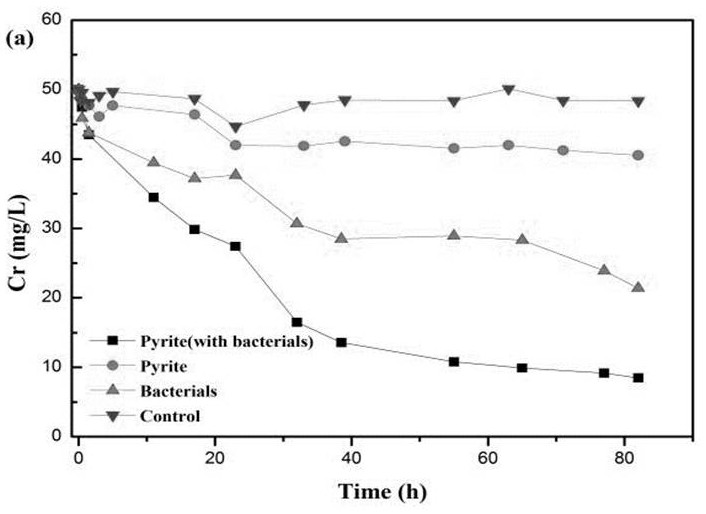Method for restoring heavy metals by regulating microorganisms through iron-containing minerals
A technology for heavy metals and microorganisms, applied in the field of biological treatment of pollutants, can solve the problems of being easily affected by environmental factors and long reaction time, and achieve the effects of enhanced electron transfer, simple operation, and easy availability of raw materials.
- Summary
- Abstract
- Description
- Claims
- Application Information
AI Technical Summary
Problems solved by technology
Method used
Image
Examples
Embodiment 1
[0030] Weigh 1 g of moist soil and 10 mL of chromium solution into 100 mL of anaerobic medium, and culture at 200 rpm and 30ºC. When the microorganisms are cultivated to the logarithmic phase, the soil particles in the culture medium are centrifugally filtered. When transferring, first mix the bacterial solutions of each culture medium in equal amounts, and then transfer and enrich again according to the amount of 10%, and cultivate at a constant temperature until the culture liquid Cloudiness occurs.
[0031] According to the inoculum volume of 1%, take 1 mL of the culture medium and transfer it to 100 mL of fresh medium as the bacteria used for inoculation. In order to minimize the loss of microbial diversity, the medium used was a nutrient-rich environment (LB) medium, and the composition of the medium was: 10 g / L peptone, 5 g / L yeast extract, 10 g / L chloride NaCl, and adjust the pH to 7.0 with HCl and NaOH.
[0032] Using the anaerobic bottle as a reactor, add 0.1 g of m...
Embodiment 2
[0035] Using the anaerobic bottle as a reactor, add 0.1 g of hematite to 100 mL of culture solution, and add the enriched microbial flora at an inoculum of 1%. Potassium dichromate (K 2 Cr 2 o 7 ) mother liquor, organic matter sodium acetate (CH3COONa) was added to the medium to make the initial Cr(VI) concentration of the system reach 50mg / L, CH3COO - The concentration is 10 mmol / L. Wherein Cr(VI) is electron acceptor, CH3COO - as an electron donor. The culture conditions were 30°C, 200 rpm, and the experiment of microorganism-mineral synergistic reduction of Cr(VI) was carried out. Sampling to detect the concentration of Cr(VI)
[0036] In order to compare the promoting effect of the present invention, two groups of contrasts are set at the same time, wherein hematite is not added in the control group 1, and all the other parameters are the same as the experimental group; only hematite is added in the control group 2, and the microorganisms of domestication are not ino...
Embodiment 3
[0038] Using the anaerobic bottle as a reactor, add 0.1 g of pyrite to 100 mL of culture solution, and add the enriched microbial flora at an inoculum of 1%. Potassium dichromate (K 2 Cr 2 o 7 ) mother liquor, organic sodium acetate (CH 3 COONa) was added to the medium to make the initial Cr(VI) concentration of the system reach 50mg / L, CH 3 COO - The concentration is 10 mmol / L. Wherein Cr(VI) is electron acceptor, CH3COO -as an electron donor. The culture condition is 30°C, 200 rpm, and the experiment of microorganism-mineral synergistic reduction of Cr(VI) is carried out.
[0039] In order to compare the promotion effect of the present invention, two groups of contrasts are set at the same time, wherein no pyrite is added in the control group 1, and all the other parameters are the same as the experimental group; only pyrite is added in the control group 2, and the microorganisms of domestication are not inoculated, and other parameters Same as the experimental group...
PUM
 Login to View More
Login to View More Abstract
Description
Claims
Application Information
 Login to View More
Login to View More - R&D
- Intellectual Property
- Life Sciences
- Materials
- Tech Scout
- Unparalleled Data Quality
- Higher Quality Content
- 60% Fewer Hallucinations
Browse by: Latest US Patents, China's latest patents, Technical Efficacy Thesaurus, Application Domain, Technology Topic, Popular Technical Reports.
© 2025 PatSnap. All rights reserved.Legal|Privacy policy|Modern Slavery Act Transparency Statement|Sitemap|About US| Contact US: help@patsnap.com



